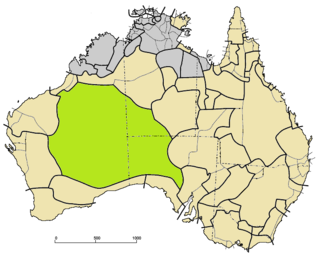Related Research Articles
Yankunytjatjara is an Australian Aboriginal language. It is one of the Wati languages, belonging to the large Pama–Nyungan family. It is one of the many varieties of the Western Desert Language, all of which are mutually intelligible.

Mutitjulu is an Aboriginal Australian community in the Northern Territory of Australia located at the eastern end of Uluṟu. It is named after a knee-shaped water-filled rock hole at the base of Uluṟu, and is located in the Uluṟu-Kata Tjuṯa National Park. Its people are traditional owners and joint managers of the park with Parks Australia. At the 2011 census, Mutitjulu had a population of 296, of which 218 (71.2%) were Aboriginal.

Aṉangu is the name used by members of several Aboriginal Australian groups, roughly approximate to the Western Desert cultural bloc, to describe themselves. The term, which embraces several distinct "tribes" or peoples, in particular the Ngaanyatjarra, Pitjantjatjara and Yankunytjatjara groups, is pronounced with the stress on the first syllable:.
Kintore is a remote settlement in the Kintore Range of the Northern Territory of Australia about 530 km (330 mi) west of Alice Springs and 40 km (25 mi) from the border with Western Australia. It is also known as Walungurru, Walangkura, and Walangura.

Papunya is a small Indigenous Australian community roughly 240 kilometres (150 mi) northwest of Alice Springs (Mparntwe) in the Northern Territory, Australia. It is known as an important centre for Contemporary Indigenous Australian art, in particular the style created by the Papunya Tula artists in the 1970s, referred to colloquially as dot painting. Its population in 2016 was 404.

The Western Desert language, or Wati, is a dialect cluster of Australian Aboriginal languages in the Pama–Nyungan family.

Pintupi is an Australian Aboriginal language. It is one of the Wati languages of the large Pama–Nyungan family. It is one of the varieties of the Western Desert Language (WDL).
The Pintupi are an Australian Aboriginal group who are part of the Western Desert cultural group and whose traditional land is in the area west of Lake Macdonald and Lake Mackay in Western Australia. These people moved into the Aboriginal communities of Papunya and Haasts Bluff in the west of the Northern Territory in the 1940s–1980s. The last Pintupi to leave their traditional lifestyle in the desert, in 1984, are a group known as the Pintupi Nine, also sometimes called the "lost tribe".
Kiwirrkurra, gazetted as Kiwirrkurra Community, is a small community in Western Australia in the Gibson Desert, 1,200 kilometres (750 mi) east of Port Hedland and 700 kilometres (430 mi) west of Alice Springs. It had a population of 165 in 2016, mostly Aboriginal Australians. It has been described as the most remote community in Australia.
Daisy Jugadai Napaltjarri was a Pintupi-Luritja-speaking Indigenous artist from Australia's Western Desert region, and sister of artist Molly Jugadai Napaltjarri. Daisy Jugadai lived and painted at Haasts Bluff, Northern Territory. There she played a significant role in the establishment of Ikuntji Women's Centre, where many artists of the region have worked.
Tjunkiya Napaltjarri was a Pintupi-speaking Indigenous artist from Australia's Western Desert region. She is the sister of artist Wintjiya Napaltjarri.
Wintjiya Napaltjarri, also known as Wintjia Napaltjarri No. 1, was a Pintupi-speaking Indigenous artist from Australia's Western Desert region. She is the sister of artist Tjunkiya Napaltjarri; both were wives of Toba Tjakamarra, with whom Wintjiya had five children.
Parara Napaltjarri was a Pintupi-speaking Indigenous artist from Australia's Western Desert region. Her paintings are included in the collection of the Art Gallery of New South Wales.
Linda Yunkata Syddick Napaltjarri is a Pintupi- and Pitjantjatjara- speaking Indigenous artist from Australia's Western Desert region. Her father was killed when she was young; her mother later married Shorty Lungkarta Tjungarrayi, an artist whose work was a significant influence on Syddick's painting.
Topsy Gibson Napaltjarri, also known as Tjayika or Tjanika, is a Pintupi-speaking Indigenous artist from Australia's Western Desert region.
Nora Andy Napaltjarri is a Warlpiri- and Luritja-speaking Indigenous artist from Australia's Western Desert region. Like her mother Entalura Nangala, Nora has painted for Indigenous artists' cooperative Papunya Tula. Her work has been exhibited at the Gauguin Museum in Tahiti, and is held by Artbank.
Ada Andy Napaltjarri is a Warlpiri– and Luritja–speaking Indigenous artist from Australia's Western Desert region. Ada was born near Haasts Bluff, Northern Territory, and has lived in several Northern Territory communities. She began painting in the early 1980s at Alice Springs and probably played a role in the development of interest in painting in the communities in which she has lived.
Ngoia Pollard Napaltjarri is a Walpiri-speaking Indigenous artist from Australia's Western Desert region. Ngoia Pollard married Jack Tjampitjinpa, who became an artist working with the Papunya Tula company, and they had five children.
Molly Jugadai Napaltjarri (c.1954–2011) was a Pintupi- and Luritja-speaking Aboriginal artist from Australia's Western Desert region. Her paintings are held in major collections, including the National Gallery of Australia.

The Luritja or Loritja people, also known as Kukatja or Kukatja-Luritja, are an Aboriginal Australian people of the Northern Territory. Their traditional lands are immediately west of the Derwent River, that forms a frontier with the Arrernte people, with their lands covering some 27,000 square kilometres (10,300 sq mi). Their language is the Luritja dialect, a Western Desert language.
References
- ↑ "SBS Australian Census Explorer" . Retrieved 10 January 2023.
- ↑ C7.1 Luritja at the Australian Indigenous Languages Database, Australian Institute of Aboriginal and Torres Strait Islander Studies
- 1 2 Heffernan, John A. (1984). Papunya Luritja Language Notes. Papunya: Papunya Literature Production Centre.